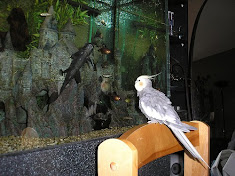Angel Fish - Pterophyllum scalare (Family: Cichlidae):
 |
| Angel Fish by Leo Lee |
The Angel Fish has a thin oval silvery body with long fins curving backwards. Vertical black stripes go from the eye through the body to the caudal fin. You will know when the fish is frightened as the dark stripes practically disappear. These stripes can hardly be seen in the Black Angel fish as the body is dark colored. The Lace Angel has fins with a black lace effect on them and a darker body then the norm. Another Angel fish, the Veil tail, has longer fins and the color is more like marble.
Unfortunately differentiating between the two sexes is extremely difficult. But when you do get a pair and they mate they act as good parents and will stay as a pair. For breeding the tank needs light that is fairly low level and densely planted with a broad leaved plant. After a couple of days the fry will hatch from the sticky eggs. It is worth bringing to your attention that when upset these fish might start eating the eggs and fry, so tread carefully and try not to frighten them - so do not frighten them! Feed the very hungry fry with infusoria initially before moving on to micro worms and brine shrimps.
Badis - Badis Badis (Family: Badidae):
 |
| Badis Badis by Tomolyka |
Normally only live food will be taken by them and a temperature range of 20 to 26 degrees Centigrade is suitable with hiding places provided by a thickly planted aquarium. Because it behaves fine with other fish the Badis is suitable for your community aquarium. However they can argue amongst themselves but injury is unlikely.
Take note of the fact that when the male is bigger than the female she can get injured during the mating process, so consider using a female that is at least the same size as the male. As the Badis is a cave dweller then use a flower pot on its side in a thickly planted breeding tank at 29 degrees Centigrade. After the eggs have been laid in the pot take the female out of the tank and wait till the eggs have hatched before taking the male out. Feed the fry on infusoria.
Black Widow - Gymnocorymbus ternetzi (Family: Characidae):
 |
| Black Widow Tetra by SaltGeorge |
The fish has bright eyes circled with red and a silver green shiny body with vertical dark bands. Seeing the differences between the sexes is not easy but the female has a fatter body and the male has wider anal and frontal fins and sharper dorsal fins. With respect to breeding the water should be at 24 degrees Centigrade, you need floating plants and plant the tank thickly at one end.
Eggs are scattered about with some dropping to the bottom of the tank and some sticking to the plants. To protect newly hatched fry, remove the male and female from the tank straight after spawning has taken place. They should be fed on infusoria to start with followed by micro worms and daphnia.
Author Resource: Written by Paul Curran
Get your FREE E-Course on how to set up and maintain a beautiful aquarium, have the healthiest, happiest fish around AND get more fresh water aquarium fish information . Paul Curran is webmaster at Fresh-Water-Aquariums-Guide.com and provides an information system for fresh water aquariums care.
Article From Pet Article World



0 comments:
Post a Comment